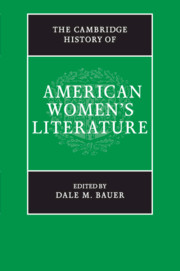Book contents
- Frontmatter
- Contents
- List of illustrations
- Acknowledgements
- Notes on contributors
- Introduction
- 1 The stories we tell: American Indian women's writing and the persistence of tradition
- 2 Women writers and war
- 3 American women's writing in the colonial period
- 4 Religion, sensibility, and sympathy
- 5 Women's writing of the Revolutionary era
- 6 Women writers and the early US novel
- 7 Women in literary culture during the long nineteenth century
- 8 Moral authority as literary property in mid-nineteenth-century print culture
- 9 The shape of Catharine Sedgwick's career
- 10 Writing, authorship, and genius: literary women and modes of literary production
- 11 Nineteenth-century American women's poetry: past and prospects
- 12 Transatlantic sympathies and nineteenth-century women's writing
- 13 Nineteenth-century African American women writers
- 14 Local knowledge and women's regional writing
- 15 Women and children first: female writers of American children's literature
- 16 US suffrage literature
- 17 American women playwrights
- 18 Turn-of-the-twentieth-century transitions: women on the edge of tomorrow
- 19 Accidents, agency, and American literary naturalism
- 20 The geography of ladyhood: racializing the novel of manners
- 21 Self-made women: novelists of the 1920s
- 22 Recovering the legacy of Zara Wright and the twentieth-century black woman writer
- 23 Jewish American women writers
- 24 Women on the breadlines
- 25 Modern domestic realism in America, 1950–1970
- 26 Lyric, gender, and subjectivity in modern and contemporary women's poetry
- 27 Contemporary American women's writing: women and violence
- 28 Asian American women's literature and the promise of committed art
- 29 Straight sex, queer text: American women novelists
- 30 Latina writers and the usable past
- 31 Where is she? Women/access/rhetoric
- 32 Reading women in America
- Index
- References
29 - Straight sex, queer text: American women novelists
Published online by Cambridge University Press: 28 September 2012
- Frontmatter
- Contents
- List of illustrations
- Acknowledgements
- Notes on contributors
- Introduction
- 1 The stories we tell: American Indian women's writing and the persistence of tradition
- 2 Women writers and war
- 3 American women's writing in the colonial period
- 4 Religion, sensibility, and sympathy
- 5 Women's writing of the Revolutionary era
- 6 Women writers and the early US novel
- 7 Women in literary culture during the long nineteenth century
- 8 Moral authority as literary property in mid-nineteenth-century print culture
- 9 The shape of Catharine Sedgwick's career
- 10 Writing, authorship, and genius: literary women and modes of literary production
- 11 Nineteenth-century American women's poetry: past and prospects
- 12 Transatlantic sympathies and nineteenth-century women's writing
- 13 Nineteenth-century African American women writers
- 14 Local knowledge and women's regional writing
- 15 Women and children first: female writers of American children's literature
- 16 US suffrage literature
- 17 American women playwrights
- 18 Turn-of-the-twentieth-century transitions: women on the edge of tomorrow
- 19 Accidents, agency, and American literary naturalism
- 20 The geography of ladyhood: racializing the novel of manners
- 21 Self-made women: novelists of the 1920s
- 22 Recovering the legacy of Zara Wright and the twentieth-century black woman writer
- 23 Jewish American women writers
- 24 Women on the breadlines
- 25 Modern domestic realism in America, 1950–1970
- 26 Lyric, gender, and subjectivity in modern and contemporary women's poetry
- 27 Contemporary American women's writing: women and violence
- 28 Asian American women's literature and the promise of committed art
- 29 Straight sex, queer text: American women novelists
- 30 Latina writers and the usable past
- 31 Where is she? Women/access/rhetoric
- 32 Reading women in America
- Index
- References
Summary
In the Introduction to the landmark collection, The New Feminist Criticism: Essays on Women, Literature, and Theory (1985), Elaine Showalter traces the evolution of feminist academic study of women writers from its birth in 1970 with Kate Millet's Sexual Politics. She notes that “the second phase of feminist criticism was the discovery that women writers had a literature of their own, whose historical and thematic coherence, as well as artistic importance, had been obscured by the patriarchal values that dominate our culture” (6). The subsequent focus on women's writing
led to a massive recovery and rereading of literature by women from all nations and historical periods. As hundreds of lost women writers were rediscovered, as letters and journals were brought to light, as new literary biographies explored the relationship between the individual female talent and the literary tradition, the continuities in women's writing became clear for the first time. (6)
In addition to her own ALiterature of theirOwn (1977), Showalter points to Patricia Meyer Spacks's The Female Imagination, Ellen Moers's Literary Women (published in 1975 and 1976, respectively), and Sandra Gilbert and Susan Gubar's The Madwoman in the Attic (1979) as beginning to define women's writing in feminist terms, which declared that starting from the time of these landmarks of feminist work, we
now have a coherent, if still incomplete, narrative of female literary history, which describes the evolutionary stages of women's writing during the last 250 years from imitation through protest to self-definition, and defines and traces the connections throughout history and across national boundaries of the recurring images, themes, and plots that emerge from women's social, psychological, and aesthetic experience in male-dominated cultures. (6)
- Type
- Chapter
- Information
- The Cambridge History of American Women's Literature , pp. 576 - 589Publisher: Cambridge University PressPrint publication year: 2012



